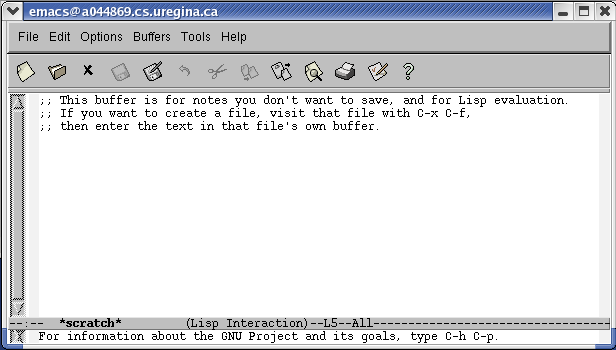The Emacs Editor
Emacs uses command key combinations to perform word processing
tasks. When you read Emacs documentation you will see commands
beginning with C- or M-. These are the
Control key and the Meta key. On most PCs the Meta key
is the Alt key.
Emacs Exercise
- To open Emacs, you can do one of the following:
- Type
emacs at a terminal command line or
- from the Applications menu select the Programming sub-menu and then select Emacs.
- Emacs will display some Help Information, and then show the following screen:

You can use Emacs on Hercules by remote connection too. Type emacs -nw filename, the -nw switch must be the first switch you use. You will be using a text only interface, but all the keystroke commands will be the same. You may have some difficulty with M- commands when using TeraTerm because Alt opens the terminal's menu. To work around this you can use Esc. Esc has the advantage of being sticky – you don't have to hold it down.
- Type C-x C-f and type the file name world.cpp.
- You should see a fresh new file. Type the following:
#include<iostream>
using namespace std;
int main()
{
cout << "Hello World!" << endl;
return 0;
}
Do you notice anything about how that was formatted? By default Emacs enforces GNU style C++ formatting.
- To save the file as world.cpp type C-x C-s. To save it with a new name type C-x C-w then the new name. Both of these options may be found in the File menu as well.
- Type C-x C-c to exit Emacs. Or select Exit Emacs from the File menu.
Congratulations! You have created a file called
world.cpp by using Emacs. More practice will
definitely prepare you better for the semester. Good Luck with
Emacs!
This is just the beginning. Emacs is VERY powerful. It can edit
multiple files simultaneously, do complex search and replace, and even
run Lisp programs. For more information on Emacs, see the
following references:
[an error occurred while processing this directive]
